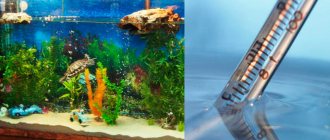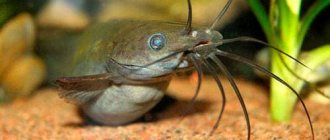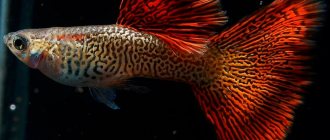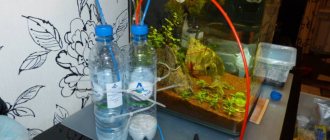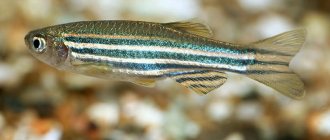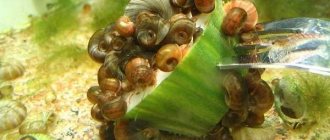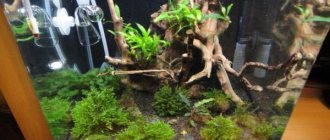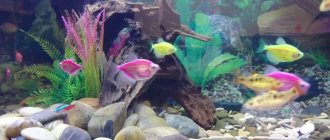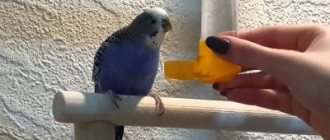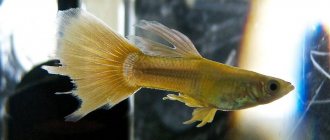Fish are cold-blooded creatures, their body temperature is determined by the temperature indicators of the surrounding space. The activity and viability of the fish depends on the comfort of the water. When the permissible degree is lowered or exceeded, the likelihood of illnesses in pets increases, but sharp temperature fluctuations are even more dangerous. There are different methods for normalizing the water temperature in a fish aquarium.
On temperature limits for warm-water and cold-water inhabitants of reservoirs
Tropical and subtropical regions are not characterized by frequent changes in water and air parameters. In Southeast Asia, the air temperature range is the same throughout the year, sometimes fluctuating within 3o Celsius (26-29 degrees), and the difference in water temperature is almost imperceptible. In South America it is hot and humid, with air temperatures of 25-28 degrees throughout the year.
There are species of fish that prefer wide temperature ranges, and there are those that live only in a narrow range. Only the fry of most fish are resistant to changes in to. When the amount of dissolved oxygen in the water decreases, all fish become less sensitive to temperature changes. Hydrobionts get used to high temperatures in a few days, and to cold temperatures in almost a month. For normal acclimatization, a gradual increase in to by 1-2 degrees and a decrease by 0.5-1 degrees is necessary.
All types of fish have their own upper and lower threshold to. Fish are sensitive to those parameters that go beyond acceptable limits. When the boundary is violated by a few degrees, the health of the fish deteriorates sharply. Frequent and sudden changes in temperature negatively affect the well-being of pets. To maintain optimal temperatures in the aquarium, you need to familiarize yourself with the permissible temperature conditions for warm-water and cold-water fish.
For warm-water fish, water below 18-20 degrees is considered unacceptable. Aquarium fish in this category are able to survive in lower ranges for a long time. But this fish requires a lot of oxygen and space, good aeration is necessary.
For cold-water fish, an unheated aquarium is suitable; 14-25 degrees is the maximum for them. They also need plenty of dissolved oxygen.
Temperature control methods
Having found out what temperature is comfortable for the fish species living in the aquarium, all that remains is to control it. Various devices are used as control devices:
- Glass coated thermometer. Provides accurate readings, is easy to use, and inexpensive. The only negative is that if the device breaks, toxic mercury will get into the water and the fish will be poisoned.
- Adhesive indicator strip. Easy to use, simply sticks to the surface of the tank. The downside is the lack of accuracy of the indicators.
- Thermometer with alcohol filler. Convenient and inexpensive option. But gradually the reliability of the indicators decreases.
- Electronic thermometer. Provides the most accurate indicators. But it's expensive.
What should be the water temperature in a home aquarium?
In order for the inhabitants of home ponds to feel comfortable, the temperature there must be at a certain level. And before you introduce a fish into your aquarium, you need to know what the natural conditions of its existence are (and most aquarium inhabitants come from the tropics).
The gradation of temperature parameters can be represented as follows:
- the optimal aquarium temperature, which is suitable for most fish, is in the range from 220 to 260C;
- the water temperature in the aquarium below the minimum optimum is no longer acceptable for warm-water fish;
- An increase in temperature above 260 is permissible by 2-40C if it is gradual.
Changes in temperature in a home pond in one direction or another from the optimal parameters are more easily tolerated by aquarium inhabitants if the water is sufficiently enriched with oxygen. It will be most difficult for well-fed fish - they require more air no matter the temperature difference. But with sudden cooling, hungry fish will also suffer.
Favorable regimes for various types of fish in the table
The inhabitants of a home aquarium come from different places and their contents are slightly different:
| Name | Comfortable temperature | Maximum | Minimum |
| Guppy | +23…+26 °С | +32 °С | +11 °С |
| Angelfish | +24…+27 °С | +33 °С | +19 °С |
| Gourami | +22…+27 °С | +33 °С | +20 °С |
| Danio | +21…+24 °С | +31 °С | +15 °С |
| Cockerels | +23…+25 °С | +29 °С | +19 °С |
| Mollies | +25…+27 °С | +34 °С | +22 °С |
| Swordtails | +22…+25 °С | +29 °С | +15 °С |
| Neons | +23…+25 °С | +29 °С | + 17 °C |
| African cichlids | +22…+24 °С | +30 °С | +20 °С |
| Tropical cichlids | +25…+28 °С | +33 °С | + 22 °C |
| Barbs | +20…+25 °С | +30 °С | + 15 °C |
| Goldfish | +20…+24 °С | +27 °С | +16 °С |
| Pterygoplichts (large catfish) | +25…+28 °С | +29 °С | +19 °С |
| Parrotfish | +21…+24 °С | +25 °С | +18 °С |
| Ancistrus | +22…+26 °С | +27 °С | + 21°C |
| Aquatic turtles, such as red-eared turtles | +24…+29 °С | +34 °С | +21 °С |
| Agamixis (catfish species) | +26…+27 °С | +32 °С | +23 °С |
| Gambusia | +20…+24 °С | + 35 °C | +12 °С |
| Astronotus | +21…+28 °С | +30 °С | +16 °С |
The optimal temperature can be raised during spawning; a constantly high temperature usually helps to shorten the life of the fish.
Ways to maintain temperature in an aquarium
As already mentioned, special means are used for a constant temperature value. These products are primarily intended for heating the aquarium. Experienced aquarists know how much room temperature affects an aquarium. The rest should remember ways to change the temperature balance of water at different times of the year:
- not everyone knows that an aquarium refrigerator is used to lower the temperature;
- if the apartment has an air conditioner, it will maintain the desired mode;
- some fans blow a fan on the water surface;
- if there is neither one nor the other, then ice can be used for cooling;
- heating is carried out by a special heater;
- when you don’t want to spend money on purchasing equipment, you can use a regular heating pad.
In any case, a person decides for himself what method he will use to heat or cool the water in the aquarium. Using professional devices, there is a guarantee of proper temperature control.
Some useful tips
To maintain optimal water temperature, you should not place the aquarium near heating devices, in rooms with sudden temperature changes, high humidity, or in direct sunlight; the compressor should be on most of the time.
A thermometer showing the water temperature should be placed in a visible place
Choose heating systems from trusted manufacturers. Thermal heating pads must have sensors. Constantly monitor the readings of the aquarium thermometer, which should be located in a convenient place in the tank, as well as other parameters of the aquatic environment.
Knowing what the water temperature should be for aquarium fish, you can create optimal and favorable conditions for your pets.
We invite you to join our Zen channel and group on VKontakte or Odnoklassniki, where new articles for pet owners are published.
Similar articles:
- What types of decorations are there for fish?
- Popular fish aquariums
- Dropsy in aquarium fish
Why is the correct water temperature so important?
Fish are cold-blooded creatures, which means their body temperature always depends on the temperature of the environment. With an optimal indicator, the fish feel good, do not get sick and do not suffer from metabolic disorders. If the water is too cold, all processes in the body slow down, immunity sharply decreases, fish become sedentary and susceptible to any infections.
When the water heats up greatly, metabolic processes accelerate, the fish become very restless, begin to consume a lot of oxygen and experience a lack of it. In this case, they swim to the surface, frantically swallowing ordinary air. Death often occurs precisely because of oxygen deficiency. The health of aquarium inhabitants is even more affected by sharp shifts in one direction or another. Already with a difference of 3–4°, the fish develop a state of shock, which very often leads to death.
Optimal temperature for different species and groups
For comfortable existence, development and reproduction of fish, a certain temperature regime of the aquatic environment in the aquarium is necessary. This is one of the main indicators that must be constantly monitored and maintained.
The course of chemical reactions, physical and physiological processes of the inhabitants of the aquarium depends on the temperature of the water.
For barbs
Barbs can be found in many countries in Europe, Asia and Africa. These fish are unpretentious and undemanding. They can thrive in both cold and warm waters. Barbs are easy to feed, breed and maintain optimal conditions for their existence.
The recommended temperature is from 20 to 27 degrees, the minimum is 15, the maximum is 30. It is desirable that the water is well aerated and has a slight current. They can be kept in any aquarium.
For guppy
In nature, guppies live in freshwater and slightly salty waters around the world. To grow beautiful and healthy fish, it is necessary to provide them with space and constant aeration of the water.
The optimal temperature is 23-26 degrees, the minimum is 14, the maximum is 32.
If guppies are kept in cool water, they grow larger, but the risk of getting sick increases.
For angelfish
Angelfish can only be found in warm tropical waters.
The norm for their existence should be within 24-27 degrees, the minimum is 19, the maximum is 33 degrees.
In warm aquariums, angelfish's immunity increases, they grow faster and begin to reproduce. But a too warm environment reduces their lifespan.
For neons
They live in the tropics of South America, preferring warm waters with a slight current.
The best temperature for keeping neons is 23-25, the minimum is 17, the maximum is 29 degrees.
Living in a body of water that is too warm dramatically reduces the lifespan of neons. If at 21 degrees neon can live up to 4 years, then at 27 it can live no more than 18 months.
For swordsmen
Under natural conditions, swordtails live in the waters of Central America, where the average temperature is 22-25 degrees. For some time, the swordtail can exist in a cool body of water up to 15 degrees. The maximum thermometer reading for the swordtail is 29 degrees above zero.
For American cichlids
There are two types:
- inhabitants of the warm waters of South America;
- inhabitants of the warm waters of Central America.
Tropical cichlids can only live in very warm waters.
The water temperature for cichlids in the aquarium is 25-28 degrees. Even at 22 degrees they can hardly exist. The upper threshold of the thermometer is 33 degrees.
Cichlids from Central America feel great in a reservoir with 21-24 degrees. They can easily live in a cool water environment of 13-15 degrees, maximum temperature is 28.
For African cichlids
Under natural conditions, they live in warm rivers, where the water can cool to 20 or heat up to 30 degrees.
The optimal temperature for keeping African cichlids is 22-24 degrees.
For Malawian cichlids
Under natural conditions they live in lakes at 24-26 degrees. This is the optimal indicator for the existence of cichlids from Lake Malawi.
You can lower the temperature to 20 and raise it to 30 degrees only for a short period of time (no more than 5-6 hours). Cichlids tolerate cool water more easily than warm water.
For cockerels
There are no cockerels in nature. They were developed through selective breeding.
The recommended temperature for cockerels is 23-25 degrees. Minimum - 19, maximum - 29.
If you keep your bettas in an aquarium with cool water all the time, they will get sick.
For zebrafish
In nature, zebrafish live in rivers and streams in southeastern Asia. The norm for their maintenance is 21-24 degrees, to stimulate its dilution it is increased to 28-29. Minimum - 15, maximum - 31 degrees.
For parrot fish
Unpretentious parrot fish can be kept in a reservoir with 21-25 degrees. Temperatures below 18 can have a negative impact on the health of the fish.
As non-tropical fish, parrots are advised to be kept in a warm environment.
For gourami
Gourami live in southeast Asia, mainly in fresh and slow-moving waters.
The optimal water environment is 22-27 degrees. A decrease to 20 and an increase to 33 degrees is possible.
When kept in cold waters for a long time, gouramis die. Even at 20 degrees they can only be kept for a few hours.
For mollies
Mollies are heat-loving inhabitants of the waters of South America.
Ideal temperature indicators are 25-27 degrees. You can lower it to 22, but not for long. The maximum should not exceed 34 degrees plus.
In nature, mollies are accustomed to living in a very warm aquatic environment; when it cools, they often develop fungal infections.
For goldfish
These are non-tropical fish that live in temperate zones, in fairly cool water.
The temperature norm for all types of goldfish is 20-24, minimum - 15, maximum - 27.
In ancient times, goldfish were kept in outdoor pools.
For catfish and catfish
More than 1,000 species of fish from different families are called catfish, so it is not easy to determine a single temperature indicator. Typically, catfish can live at a temperature closer to room temperature, 22-25 degrees. To stimulate reproduction, increase it by 2-3 degrees.
Different types of catfish live in different regions of the planet:
- Pterygoplichts are inhabitants of the tropics. The optimal temperature environment is 25-28 degrees, you can briefly lower it to 22, raise it to 30;
- Agamixis - live in warm water. The optimal temperature environment is 26-27, minimum - 23, maximum - 32;
- Bunocephalians are small predators. In nature, they live in the reservoirs of Central America, preferring cool temperatures; the ideal thermometer reading is 21-23 degrees;
- Synodontis is a family of catfish that can live at room temperature. Optimal - 21-25, minimum - 19, maximum - 29.
For crabs and shrimp
Most shrimp kept in aquariums come from Asia. These are hardy creatures. All types of aquarium shrimp are not picky about their housing conditions. The ideal temperature for keeping is 24-25 degrees, the minimum is 15, the maximum is 30. If the temperature in the apartment is not lower than 17 degrees, then you can keep shrimp without heating.
Crabs are quarrelsome arthropods that cannot tolerate their neighbors, even their own relatives. They live mainly in salt water, but there are also freshwater species that take root at home.
Types of crabs:
- rainbow - grows up to 15 cm;
- leopard - a freshwater creature, aggressive, kept only in pairs (female + male);
- mango - unpretentious, 4.5 cm;
- freshwater Dutch - 2-3 cm, omnivorous and peaceful.
The temperature norm for crab is 22-26 degrees. Failure to comply with these parameters can lead to the death of arthropods.
For aquatic turtles
Usually tropical species live in aquariums, but currently the red-eared turtle species is popular. It is a heat-loving creature that cannot tolerate cool temperatures.
The optimal thermometer reading is 24-29 degrees. For a short time you can lower it to 21, the maximum is 34 degrees.
How to help fish with overheating or hypothermia
In extreme situations, when due to accidental failure of equipment the optimal water temperature may be disrupted, there is very little time left to save the inhabitants. Therefore, measures must be taken very quickly. But most often there is no spare heater at hand, and every minute counts. If the water has cooled down too much, you can warm it up a little by adding warm, but not hot, liquid so that the changes occur smoothly, by 2°C in 15-20 minutes.
But you can add no more than 10% of fresh water from the total volume of the aquarium. If the warming is not enough, then a plastic bottle of hot water lowered into a pond can help. In the most critical situations, when time is lost and the fish are so frozen that they lie on the bottom, barely showing signs of life, you can pour vodka into the water in a volume of 20-30 ml per 100 liters of container. Warming measures must be taken immediately. After the regime is restored, you will need to replace about 1/3 of the water to get rid of alcohol. Overheating is no less dangerous. An increase in temperature of 4°C from the usual is already dangerous for any species. The first aid in this case is maximum saturation of water with oxygen. You can turn on the aerator or mix the water by hand, add 20-25 ml of hydrogen peroxide per 100 liters of volume. A bottle of cold water in the aquarium will also help reduce the temperature. To prevent infections and parasitic infestations as a result of decreased immunity in fish due to hypothermia or overheating, broad-spectrum drugs should be used.
Is it true that cichlids tolerate different temperature ranges?
Cichlids require keeping in warm water, since this water temperature produces the secretion of enzymes for a rich body color and stimulates them to spawn. Cichlids have a high tolerance for both high and low temperatures, but not more than 6 hours. The tank can be maintained at a medium temperature range. When cichlids are kept at elevated temperatures, their color quickly becomes saturated, but they become exhausted and live less.
At low temperatures, the color of cichlids fades, and the fry grow and develop slowly. The permissible temperature for keeping cichlids is 24-30 degrees. The limit is 24-27 degrees. For Tanganyika cichlids, the water should not be warmer than 29 degrees. When treating certain diseases of cichlids, to is increased for a while.
Cichlids are truly one of the hardiest fish in the aquarium; for a novice aquarist, many representatives of this family will be excellent pets. However, all types of fish require careful care, which should not be forgotten.
What to do if there are temperature changes?
Fish most often suffer from sudden temperature fluctuations when transported from a pet store to a new home. Usually, owners transport purchased pets in a small jar or bag. In summer, fish can die due to heat and stuffiness, in winter due to the sharp cold outside the store.
To prevent illness and death of pets from temperature changes, it is recommended to transport them in a thermos. If a large thermos is not at hand, then the purchase should be made at a pet store close to your home so that the fish’s journey does not take much time.
Beginning aquarists should not only find out the preferred temperature for each type of fish, but also purchase heating and cooling equipment in order to act quickly in a critical situation. In unfavorable temperature conditions, fish are stressed, get sick, live short lives, but in favorable temperature conditions they delight with their beauty for a long time.
How to lower the temperature in a pond
A failed temperature sensor on the heating pad or close proximity to the heating system can cause a sharp increase in temperature in the aquarium. Even the sun's rays in summer will quickly warm a home pond if it is located on a southern windowsill. Try to ensure that the water parameters do not exceed 300C, otherwise the aquarium will turn into something like a cauldron with fish soup.
- The same plastic bottle, but already filled with cold water or ice, can save the fish. The temperature should be lowered gradually.
- Keep the compressor running continuously until the temperature can be reduced to normal. Increased aeration will allow the fish to breathe with “full gills.”
- 1 tbsp will also help enrich the water with oxygen. hydrogen peroxide (per 100-liter container). This pharmaceutical preparation will simultaneously disinfect the reservoir, destroying parasites.
It should be borne in mind that an increase in temperature is more contraindicated for aquarium fish than a decrease in temperature. Here, the poor health of aquatic inhabitants can also be affected by the presence of various nitrates in the water, which are especially harmful at elevated temperatures.
Thermometers
When kept in an aquarium, the water temperature requires careful monitoring. The possibility of sudden changes depends on the volume of the aquarium and the power of its heating or cooling devices.
Thermometers are used to measure the heat of a liquid. It is placed further from the heater, in the middle of the aquarium.
Thermometers come in 2 types depending on location:
- Outer. Attaches to the outer wall. Due to the location, the measurement results have a large error. Because the thermometer is also influenced by the air, which is often colder.
- Submersible (internal). It will be the best solution. Located inside the reservoir. The internal thermometer has a small measurement error and indicates a correct reading.
According to the type of action, thermometers are divided:
- Glass thermometer with mercury reading.
- Liquid crystal thermometer (self-adhesive strip on glass).
- Digital Thermometer.
- Alcohol thermometer.
Find out in advance what temperature should be in the fish aquarium.
The temperature must be monitored
Experienced aquarists have long protected themselves from such troubles as the need to lower or increase the degrees. To keep fish within optimal temperature limits, the following rules should be taken as a basis.
- Choose the “right” place for the aquarium: away from heating devices, air conditioners, away from direct sunlight (especially in summer) and drafts.
- The heating pad must be of high quality and have a reliable sensor.
- A thermometer is a must-have device for any aquarium. Select its location so that it is convenient to monitor the scale indicators.
- Aeration is not a fad, so the compressor should be turned on regularly. Without enough air, what kind of habitat would be comfortable?
HOW TO CORRECTLY INSTALL THE INTERNAL FILTER IN AN AQUARIUM
HOW OFTEN DO YOU NEED TO CHANGE THE WATER IN AN AQUARIUM?
HOW TO RESTART AN AQUARIUM AFTER ILLNESS OR DEATH OF AQUARIUM FISH
How to measure indicators?
There are several ways to determine the temperature of aquarium water: using a thermometer, an indicator strip, and focusing on the water heater.
Thermometer
Several types of thermometer are used in aquarium keeping, each of them has its own advantages and disadvantages:
- Alcoholic. The most accurate, but since it is made of glass, it is easy to break.
- Electronic (internal). Also quite accurate, but expensive.
- Electronic (remote). Only the sensor is placed in the water; the digital display remains outside the aquarium. It has a high degree of error.
Alcohol thermometers are the most popular due to their optimal price/quality ratio.
Heater
Modern aquarium heaters are equipped with a sensor. When the device is working, the light is on, when it heats the water to the set temperature, it turns off and the light goes out.
You should not seriously consider this method, since the heater may fail at any moment, it may jam, or it may not work entirely correctly.
indicator strip
This is a crystal thermometer that is glued to the glass of the aquarium.
Depending on the temperature, a certain area on the strip begins to color , the inscription on which corresponds to the temperature of the reservoir.
This strip looks quite aesthetically pleasing, but the accuracy of its readings leaves much to be desired.
Aquarium water heaters
A heater is a device that lasts a long time. Our advice is not to skimp and choose a heating pad carefully. Today there are two types of heaters - immersion and flow-through. There are different modifications of them, for example, bottom, fixed - with a preset temperature. There are also differences in size.
Let's look at each option in more detail. And let’s do this using ISTA heating pads (Taiwan) as an example; they are widely represented on the market and combine the best in price and quality.
AQUARIUM HEATER AND EVERYTHING YOU NEED TO KNOW ABOUT IT.
The most important condition for the favorable functioning of your aquarium is maintaining a certain temperature that is optimal for a particular type of fish. Typically, fish need a temperature of 22 to 32 degrees, depending on their species. Until recently, aquarists actively used simple heaters. Some specialized stores still sell heaters, but purchasing them is not recommended. Now the blessed era of thermostats has arrived. The power of thermostats depends on how large the aquarium is. Experts recommend a power of 1.5 watts per 1 liter of water. For example: a 100 liter aquarium will require a 150 watt heater. Fish owners should also know that the colder the room, the faster the water in the aquarium cools, and the greatest cooling occurs in aquariums with a large area of its walls. Therefore, it is best to purchase heaters “with a reserve”, i.e., more powerful ones. Such heaters easily and quickly cope with temperature drops, operate smoothly, without overheating, and last much longer. But powerful heaters must be of high quality. It would also be useful to know that the cost of a heater does not particularly depend on its power, and neither does energy consumption. The whole question is the reliability of the device, i.e., the thermostat and the heating element. If the thermostat of a powerful heater breaks down, the inhabitants of the aquarium have two little comforting options - to die either from the cold or from an unusually high water temperature. Some, in order to avoid such sad consequences, purchase 2 medium-power heaters. If one thermostat fails, another will maintain the optimal living environment. If one of the thermostats breaks, the water will not reach a critical temperature, and the fish will eventually be fine. But, as you know, good things don’t come cheap. A couple of high-quality heaters will cost you twice as much as one simple one. The right to choose is yours.
Using a water heater
How to install a heater in an aquarium
The heater is waterproof and can be installed in the aquarium either in a vertical position - with the adjustment handle located above the water surface, or in a horizontal position - completely submerged. Do not insert the heater into sand or gravel . The water level must always be above the minimum immersion level, the MINIMUM WATER LEVEL mark marked on the heater body. It is necessary to remember that the water level is constantly decreasing as a result of evaporation. The heater is attached to the wall of the aquarium using a bracket with two suction cups, which should be attached to the heater directly below the head. The heater must be fixed in the aquarium in a place where there is constant and uniform circulation of water. ATTENTION! Only about 15 minutes after installing the heater in the aquarium, when the temperature of the bimetallic switch in the heater becomes equal to the temperature of the water in the aquarium, can the heater be connected to the power supply.
| Aquarium volume, l | Difference between water temperatures in the aquarium and in the room, °C | |||||||
| 2 | 4 | 6 | 8 | 10 | 12 | 15 | 20 | |
| 20 | 5 | 12 | 17 | 22 | 29 | 34 | 59 | 80 |
| 40 | 9 | 18 | 26 | 36 | 46 | 55 | 100 | 125 |
| 60 | 12 | 23 | 35 | 47 | 59 | 70 | 128 | 140 |
| 80 | 14 | 29 | 43 | 56 | 70 | 85 | 144 | 170 |
| 100 | 17 | 33 | 49 | 66 | 82 | 99 | 150 | 200 |
| 150 | 20 | 43 | 65 | 86 | 108 | 127 | 200 | 250 |
| 200 | 26 | 52 | 78 | 104 | 130 | 156 | 210 | 300 |
| 250 | 30 | 60 | 91 | 121 | 150 | 182 | 270 | 360 |
| 400 | 42 | 82 | 124 | 169 | 208 | 247 | 390 | 500 |
Types of Aquarium Heaters
DIY aquarium heater
conclusions
Aquarium heater with thermostat
The main inconveniences when using the heater are related to the need to constantly monitor its operation. Even having reached the desired water temperature, the device still continues to function and must be disconnected from the network manually.
To get rid of this problem, a special device is used - a thermostat, which is a device with a built-in temperature sensor. It allows you to turn off the heating element when a preset value is reached and turn it on again when the water begins to cool.
This ensures a stable microclimate without temperature changes. The use of modern technologies makes it possible to produce very compact and easy-to-use thermostats.
According to manufacturing technology, they are divided into two types.
Electronic . They are highly accurate (most of them are equipped with an information board). Disadvantages include the relative high cost and lack of reliability.
Mechanical . They are found most often, are characterized by stability and reliability during operation, and are cheaper in price. They often distort real readings by several degrees, so to accurately adjust the device, you must use a separate thermometer.
According to the level of safety during operation and durability of the devices, thermostats are divided into:
- Remote - located outside the aquarium, not affected by the aquatic environment and the waste products of aquatic organisms. This increases their service life and makes it possible to use cheaper heaters and replace them without additional costs. To determine the operating mode, a separate temperature sensor is used, which is located in the aquarium and connected by a wire to the thermostat.
- Built-in - mounted in a sealed housing together with a heating element. With this configuration, the entire water control and heating system becomes very compact and easy to use.
Spiral-heater-for-aquarium
The latter type of design is the most popular among aquarists and is often made in the form of an elongated glass flask, inside of which there is an electric heater and thermostat. For greater thermal conductivity, the space of the flask is filled with the smallest ceramic filler.
The tightness of the structure is ensured by a rubberized or plastic cap through which the power wire passes. There is also a regulator here that allows you to set the required temperature.
Well-known brands of aquarium equipment - Eheim, Fluval, Ferplast, Aquael, Tetra - produce reliable and high-quality submersible heaters for aquariums with a power thermostat from 25 to 300 W. Such devices are capable of providing the necessary conditions in aquariums up to 1500 liters.
To reduce the likelihood of water overheating, there is a practice of simultaneously using several less powerful thermal devices.
If it is not possible to purchase the necessary equipment, you can make it yourself.
READ ALSO MOLLINESIA
aquarium-fish-home.ru>
Monitoring and regulation
In order to prevent temperature changes, it is important to monitor the regime; this can be done using aquarium thermometers . They come in several types:
- mercury;
- liquid crystal;
- electronic;
- alcoholic.
It is best to choose submersible specimens, they are the most accurate. The thermometers are mounted on suction cups in the middle or closer to the bottom of the aquarium. Their only drawback is in the method of fastening, because the suction cups are often of poor quality, which means the device will fall. In addition, some fish themselves like to throw off the thermometer.
Water heaters are used for regulation. They look like a glass flask with a metal spring inside. At the top there is a lever and divisions; the heater must be set to the required mode and it will heat the water. But it is important to remember that when cleaning the aquarium, the device must be unplugged from the network, because it is prohibited to remove it from the water when it is turned on; it may burst.
